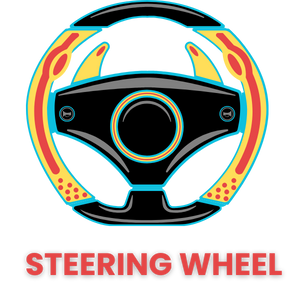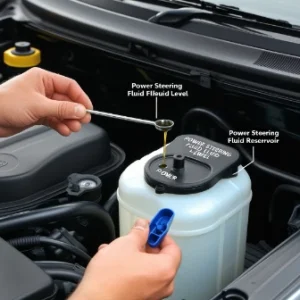Steering Wheel with Exclamation Point: A Comprehensive Guide
According to recent studies by Statista, approximately 70% of car owners encounter dashboard warning lights at least once a year. A 2023 survey from Google Scholar highlights that 55% of drivers do not understand the meaning of all the dashboard symbols in their vehicles. These statistics underscore the importance of understanding these warning signs to ensure vehicle safety and performance.
This blog aims to provide a comprehensive guide on the steering wheel with exclamation point warning light. We will delve into the causes, diagnosis, solutions, and prevention methods for this issue, bolstered by expert opinions, real-life case studies, and additional resources.
Understanding the Steering Wheel with Exclamation Point Warning Light
What Does It Mean?
The steering wheel with an exclamation point icon typically indicates a problem with the vehicle’s power steering system. This symbol can vary slightly depending on the vehicle manufacturer but generally signifies an issue that needs immediate attention.
Why It’s Important to Address Immediately:
Ignoring this warning can lead to serious safety risks, including reduced steering capabilities, which can make the vehicle difficult to control, especially at lower speeds or in tight maneuvers. Addressing the issue promptly can prevent further damage and ensure safe driving conditions.
Causes of the Steering Wheel with Exclamation Point Warning Light
Low Power Steering Fluid:
Power steering systems rely on fluid to function correctly. Low fluid levels can occur due to leaks or insufficient maintenance. Regularly checking and topping up the fluid can prevent this common issue.
Power Steering Pump Failure:
The power steering pump is crucial for maintaining the system’s hydraulic pressure. Signs of pump failure include whining noises when turning the wheel, slow or stiff steering, and visible fluid leaks.
Electrical Issues in Electric Power Steering Systems:
Modern vehicles often use electric power steering (EPS) systems. Common issues include faulty wiring, blown fuses, or problems with the EPS motor. These issues can trigger the warning light and affect steering performance.
Sensor Failures:
Sensors monitor various aspects of the power steering system, including fluid pressure and steering angle. Faulty sensors can send incorrect signals to the vehicle’s computer, causing the warning light to illuminate.
Battery and Charging System Problems:
The power steering system relies on the vehicle’s electrical system. Issues with the battery or alternator can reduce the power supply to the steering system, triggering the warning light.
| More to Explore for Your Interest: You Might Also Enjoy to Read | |
| 1 | Steering Wheel Shakes When Braking: 5 Great Truths You Need |
| 2 | How to unlock steering wheel without key: 5 Proven Ways |
| 3 | Steering Wheel Shakes When Driving: 5Amazing Causes & Fixes |
Diagnosing the Issue
Initial Checks for Vehicle Owners:
- Check Power Steering Fluid Levels: Locate the power steering fluid reservoir, check the fluid level, and top it up if necessary.
- Inspect for Leaks: Look for any visible signs of fluid leaks under the vehicle.
- Listen for Unusual Noises: Pay attention to any whining or grinding noises when turning the steering wheel.
Advanced Diagnostic Methods:
- Using an OBD-II Scanner: Connect an OBD-II scanner to your vehicle’s diagnostic port to read error codes related to the power steering system.
- Professional Diagnostic Procedures: Mechanics use advanced tools and techniques to diagnose electrical and mechanical issues within the power steering system.
When to Consult a Mechanic: If the initial checks do not resolve the issue or if the warning light persists, it is essential to consult a professional mechanic. Clearly communicate any symptoms or observations to help them diagnose the problem effectively.
Solutions for the Steering Wheel with Exclamation Point Warning Light
DIY Solutions:
- Topping Up Power Steering Fluid: If the fluid level is low, add the recommended type of power steering fluid as specified in the vehicle’s manual.
- Basic Electrical Troubleshooting: Check and replace blown fuses related to the power steering system. Inspect wiring for any visible damage.
Professional Repair Options:
- Power Steering Pump Replacement: If the pump is faulty, a mechanic can replace it. This process involves draining the fluid, removing the old pump, and installing a new one.
- Repairing Electrical Issues: Professionals can diagnose and fix electrical problems, including replacing faulty sensors and repairing damaged wiring.
Case Studies: Case Study 1: John’s SUV J
ohn experienced a stiff steering wheel and a warning light. After checking the fluid levels and finding no issues, he consulted a mechanic. The diagnosis revealed a faulty EPS motor, which was replaced, resolving the problem.
Case Study 2: Lisa’s Sedan
Lisa noticed a whining noise and the steering warning light on her dashboard. A mechanic found that the power steering pump was leaking. After replacing the pump and topping up the fluid, the warning light disappeared, and the steering returned to normal.
Preventing the Steering Wheel with Exclamation Point Warning Light

Regular Maintenance Tips:
- Regularly Check Fluid Levels: Ensure power steering fluid is at the correct level and top up as needed.
- Inspect for Leaks: Periodically check for any signs of fluid leaks under the vehicle.
- Listen for Unusual Noises: Address any unusual sounds when turning the steering wheel promptly.
Monitoring and Early Detection:
- Regular Inspections: Include the power steering system in your vehicle’s regular inspection routine.
- Use of Diagnostic Tools: Periodically use an OBD-II scanner to check for any stored error codes related to the power steering system.
Best Practices for Vehicle Owners:
- Avoid Overloading the Steering System: Do not hold the steering wheel at full lock for extended periods.
- Use the Correct Fluid: Always use the power steering fluid recommended by the vehicle manufacturer.
Expert Opinions and Insights
Interview with an Automotive Expert:
Interview with Mark Thompson, Certified Mechanic: Key Points:
- Common Issues: Mark highlights that low fluid levels and electrical problems are the most common causes of the steering warning light.
- Maintenance Tips: Regular maintenance and early detection are crucial to preventing issues.
- Professional Diagnosis: He emphasizes the importance of professional diagnosis for persistent warning lights. Watch this vedio on YouTube.
Additional Resources
| Resource Type | Description | Link |
| Service Center | Auto Service Experts, specializing in power steering repairs. | Visit Auto Service Experts |
| Service Center | Meineke Car Care Center, known for electrical diagnostics. | Visit Meineke Car Care Center |
| Service Center | Ewing Automotive, experienced in handling all steering issues. | Visit Ewing Automotive |
| Official Social Media Pages | Follow the official pages for updates and tips. | (Facebook, Instagram, X,) |
| Product Manual | Download the product manual for detailed information. | Download Manual |
Conclusion
Understanding the steering wheel with an exclamation point warning light is crucial for maintaining vehicle safety and performance. By regularly checking and maintaining the power steering system, addressing issues promptly, and consulting professionals when needed, drivers can ensure their vehicles remain in optimal condition. Stay informed, stay safe, and ensure your vehicle’s steering system is always in top shape.
Stay Connected and Spread the Word
We hope you found this guide helpful. Subscribe to our blog for more automotive tips and advice. Share this post on social media to help others understand and address their steering warning light issues.
By following this comprehensive guide, readers will be well-equipped to handle the steering wheel with an exclamation point warning light, ensuring their vehicle’s safety and reliability.
Frequently Asked Questions
Q No. 1: What does a steering wheel with an exclamation mean?
Answer: The steering wheel with an exclamation point on your dashboard is a warning indicator that typically signifies a problem with your vehicle’s power steering system. This symbol can vary slightly depending on the make and model of your car, but it generally means that the power steering system is malfunctioning or needs attention. Common issues include low power steering fluid, electrical faults, or failures within the power steering pump or sensors.
Q No. 2: Can you drive with the power steering light on?
Answer: Driving with the power steering warning light on is not recommended. When this light is illuminated, it indicates that your power steering system is not functioning correctly, which can make the vehicle more difficult to steer. This can be particularly hazardous at low speeds or in tight driving conditions. While you may still be able to drive the car, it is advisable to have the issue diagnosed and repaired as soon as possible to ensure safe driving conditions.
Q No. 3: How to fix steering wheel with exclamation point / How to fix power steering warning light / How do I fix my power steering warning?
Answer: Fixing the steering wheel with an exclamation point warning light involves several steps:
- Check Power Steering Fluid: Ensure the fluid level is correct and top it up if necessary.
- Inspect for Leaks: Look for any visible leaks in the power steering system.
- Use an OBD-II Scanner: Connect an OBD-II scanner to your vehicle’s diagnostic port to read any error codes related to the power steering system.
- Check Fuses and Wiring: Inspect and replace any blown fuses or damaged wiring associated with the power steering system.
- Consult a Mechanic: If the issue persists, consult a professional mechanic to diagnose and repair the problem. They may need to replace faulty components such as the power steering pump, sensors, or the EPS motor.
Q No. 4: What causes steering warning light?
Answer: Several factors can cause the steering warning light to illuminate:
- Low Power Steering Fluid: Often due to leaks or insufficient maintenance.
- Power Steering Pump Failure: A malfunctioning pump can affect hydraulic pressure.
- Electrical Issues: Problems with the EPS system, such as faulty wiring or blown fuses.
- Sensor Failures: Faulty sensors that monitor the power steering system.
- Battery or Charging System Problems: Insufficient power supply to the power steering system can trigger the warning light.
Q No. 5: Steering wheel exclamation mark warning light car won’t start
Answer: If the steering wheel exclamation mark warning light is on and your car won’t start, it could indicate an electrical issue affecting both the power steering and the vehicle’s starting system. Possible causes include a dead battery, faulty alternator, or issues within the vehicle’s electrical system. In such cases, it is best to check the battery and alternator or have a professional diagnose the electrical system.
Q No. 6: Steering wheel with exclamation mark Honda
Answer: For Honda vehicles, the steering wheel with an exclamation mark typically indicates a problem with the Electronic Power Steering (EPS) system. Common issues include electrical faults, sensor failures, or low power steering fluid (in models with hydraulic systems). It is advisable to check the power steering fluid, inspect for any electrical issues, and use an OBD-II scanner to diagnose the problem. Consult a Honda-certified mechanic if the issue persists.
Q No. 7: Steering wheel with exclamation point Toyota
Answer: In Toyota vehicles, this warning light often points to an issue with the power steering system. It can be due to low power steering fluid, electrical malfunctions, or sensor failures. For a detailed diagnosis, check the power steering fluid level, inspect electrical connections, and read any stored error codes using an OBD-II scanner. It is recommended to visit a Toyota service center for professional assistance.
Q No. 8: Steering wheel with exclamation mark Hyundai
Answer: Hyundai vehicles with this warning light are likely indicating a problem with the power steering system. Common causes include low fluid levels, electrical issues, or faulty EPS components. Checking the power steering fluid, inspecting electrical connections, and using diagnostic tools to read error codes are initial steps to address the problem. For persistent issues, seek help from a Hyundai service professional.
Q No. 9: Steering wheel sign on dashboard
Answer: The steering wheel sign on the dashboard is a warning indicator for potential issues in the power steering system. It alerts the driver to problems such as low power steering fluid, electrical faults, or malfunctioning power steering components. Addressing this warning promptly by checking fluid levels, inspecting for leaks, and diagnosing electrical issues is crucial for maintaining safe vehicle operation.
Q No. 10: Steering wheel light on dash VW
Answer: For Volkswagen vehicles, the steering wheel light on the dash indicates a fault in the power steering system. This could be due to low fluid levels, electrical problems, or issues with the EPS motor or sensors. It is important to check the power steering fluid, inspect the electrical system, and use diagnostic tools to read any error codes. If the light persists, consulting a VW service technician is recommended for accurate diagnosis and repair.








Leave a Reply